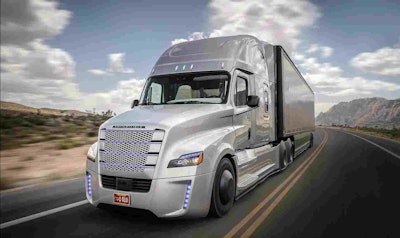
His father has always driven a truck, but Stawinski didn’t inherit a business. Instead, he chose a different path to jumpstart a career in transportation.
Straight out of high school, he went to work for Coyote Logistics in Chicago. As a third party logistics (3pls) provider, Coyote makes trucking appealing to young people, he says, with a fast-growth technology culture.
“Being younger, I understand why and how technology can change the industry and the game,” he says.
After two years at Coyote, he started Percy Transportation with some business parters. The Chicago-based carrier specializes in local and cross-border movement of temperature-controlled goods.
Today, Percy Transportation has 30 trucks, of which 28 are owner operator assets and two are company owned.
While not in the office, Stawinski is busy completing a bachelor’s degree in logistics and supply chain management. Recently, he had a discussion with a professor that solidified his decision to use the owner-operator model. He is preparing for the possibly of buying driverless trucks in five to 10 years.
Cloud-based transportation management software (TMS) is another technology Stawinski is evaluating. Recent developments have made the technology affordable for small carriers to stay connected to their customers and prospects.
Percy Transportation currently uses Excel spreadsheets and “a mix of other things” to manage information. Its office personnel use different systems and websites, he says, and dispatchers are calling and texting drivers.
“I’m always looking for better ways to improve efficiency,” he says.
 The Tracks TMS platform captures tracking data from drivers.
The Tracks TMS platform captures tracking data from drivers.During the past month, Stawinski has been testing a beta version of the Tracks TMS system from Cargo Chief, a tech-enabled 3pl based in Mountain View, Cal. The user interface of Tracks TMS is similar to that of a well-known software developer in Silicon Valley, Stawinski says. He describes the interface as “clean and simple,” just like Apple iOS.
Tracks TMS has the potential to do everything, he says, from finding loads to tracking shipments, invoicing customers, paying drivers and managing equipment.
“I am really a fan of it. I know it will help my business,” he says. And the price seems right for small carriers. “Right now, I know I don’t want any other system.”
But there is one catch. Stawinski is concerned that Cargo Chief, a freight broker and 3pl, would be able to access data he imports into Tracks TMS such as his customer information and pricing.
Abtin Hamidi, executive vice president of Cargo Chief, says he understands the concern. He confirmed with CCJ that carriers have the option to give Cargo Chief visibility of their customers, pricing and lanes. But it is by choice. They can also choose not to.
 Tom Stawinski, owner and president of Percy Transportation
Tom Stawinski, owner and president of Percy TransportationCarriers can use Tracks TMS as a stand-alone system, he explains. In this case, Cargo Chief might still ask the carrier for permission to gather pricing data anonymously, as other TMS providers do, to improve the accuracy of its freight pricing algorithm, he says.
If there is a potential conflict, such as if Cargo Chief and a carrier have a mutual customer, Cargo Chief will notify the carrier, Hamidi says. Cargo Chief would likely be offering the carrier additional business from the same customer, acting as a broker, he adds.
The launch of Tracks TMS supports Cargo Chief’s mission to connect small and medium-size carriers to shippers. The company will be able to use data from its growing community of Tracks TMS users to determine which lanes are the best fit for the carriers, and reward them with more business that fits their specific needs, he says.
“It helps to match up freight at the highest level of efficiency. You can only get that if everyone has data in the same system,” he says. “Beyond that, we can give advice for where carriers can move their trucks to get the best loads.”
“The problem we are trying to solve is to create a better economy and ecosystem for small to medium sized fleets,” he continues. Simultaneously, Cargo Chief is working on a similar TMS for shipping departments to instantly book capacity. “We can do a lot of different things.”












